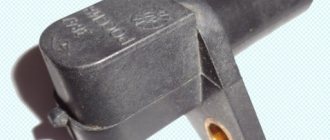VAZ 2111 fuel consumption per 100 km is very important for car owners, and especially for buyers. After all, a car shouldn’t be expensive for a family.
Fuel consumption on the 8 valve VAZ 2111 depends on several factors
:
- engine capacity;
- year of car manufacture;
- driving style;
- road surface;
- technical condition of the motor.
| Engine | Consumption (city) | Consumption (highway) | Consumption (mixed cycle) |
| 1.6 (petrol) 5-mech | 10 l/100km | 6 l/100km | 7.5 l/100km |
| 1.5 (petrol) 5-mech | 9.1 l/100km | 5.6 l/100km | 7.7 l/100km |
| 1.8 (petrol) 5-mech | 11.8 l/100km | 9.5 l/100km | 10.5 l/100km |
| 1.6i (petrol) 5-mech | 10.1 l/100km | 6.3 l/100km | 7.7 l/100km |
The quality of gasoline and its octane number are also of great importance. It is very important to fill the tank with good, proven fuel. Next, we’ll talk more specifically about what increases the volume of fuel and how to reduce fuel consumption on an injection VAZ 2111.
Official data (l/100 km)
| Engine | Consumption (city) | Consumption (highway) | Flow (mixed) |
| 1.5 MT 72 hp (Mechanics) | 9.1 | 7.5 | 8.2 |
| 1.5 MT 79 hp (Mechanics) | 10.0 | 5.7 | 7.3 |
| 1.5 MT 92 hp (Mechanics) | 8.8 | 5.5 | 7.5 |
| 1.5 MT 94 hp (Mechanics) | 9.1 | 7.5 | 8.2 |
| 1.6 MT 81 hp (Mechanics) | 9.1 | 5.6 | 7.5 |
| 1.6 MT 89 hp (Mechanics) | 9.1 | 7.5 | 8.2 |
| 1.6 MT 90 hp (Mechanics) | 10.0 | 5.7 | 7.3 |
| 1.7 MT 79 hp 4x4 (mechanics) | 11.8 | 9.5 | 10.3 |
| 1.8 MT 82 hp 4x4 (mechanics) | 11.8 | 9.5 | 10.3 |
The main engine of the VAZ 2111 was a 1.5-liter unit, which could develop a power of either 79 horsepower (8-valve injector) or 92 hp. (16 valve injector). Fuel consumption per 100 km for such an engine varied from 7.2 to 7.6 liters.
The second engine is 1.6 liters, with peak power from 81 to 90 horsepower. Everything here also depends on the number of valves and the method of fuel supply. The average consumption of such configurations varies from 7.3 to 7.5 liters.
The next power unit had a volume of 1.7 liters. It was capable of producing 79 horsepower. Along with this engine, an all-wheel drive system was installed. Smaller engines were equipped only with the front one. Gasoline consumption here was at 12 liters.
And the last engine - 1.8 liters, which had 82 horsepower, was also equipped with all-wheel drive. It consumed as much fuel as the previous engine. All versions of power units were equipped with only a manual transmission operating in five modes. The model also had several modifications. Three of them had two valves on each cylinder. These are versions 21110, 21111, 21112.
The first had a one and a half liter engine with fuel injection and a power of 77 hp. The second model was equipped with exactly the same engine, but with a carburetor. And the third was equipped with a 1.6 liter engine with a power of 82 hp. The injector was responsible for supplying fuel here. There were also three versions with sixteen-valve engines: 21113 (1.5 liters, 93 hp), 21114 (1.6 liters, 89 hp) and 21116 (2.0 liters, 150 hp). An injector was installed everywhere, and the latest version also had an all-wheel drive system.
Owner reviews
“I liked the car because it was spacious, and this was the main parameter by which I chose a car. As it turned out later, he also drives well. The car is already more than 10 years old, and it has never broken down yet, which is quite strange for our models. I use it often, mainly around the city for various work tasks, but sometimes I have to travel long distances, for example, to the country. The model shows itself only from its best side everywhere. As for consumption, everything is a little bad. I have a 1.7 liter engine. It eats up to 15 liters in the city,” writes Alexey from Novgorod.
“I bought this car from a neighbor because I urgently needed a car that has a lot of space. Initially I doubted it, but when I drove it a little and saw the consumption, I took it without any doubt. Now I often drive it for work purposes, transporting small loads. I also sometimes travel to the countryside, since the trunk and interior can accommodate all the tools and various seedlings. In terms of consumption, I’ll say that I’ve never spent more than 10 liters,” says Vasily from Tyumen about his car.
“I won’t say that I am the proud owner of this car, since it often lets me down and breaks down at the most inopportune times. I have already spent a lot of money on its repairs and maintenance, and I even thought about selling it. Although it’s a shame, since this is an excellent work car in which you can fit everything and safely drive it to your destination, while consuming a minimum of fuel. I only spend 9 liters, no more,” wrote Alexander from Penza.
“My father gave me the car when I got my first job as a courier. It was very useful to me and made my life a lot easier, since there is a lot of space in it, I could easily store all my goods for the day, it drives briskly, and consumes little fuel. Although many, as I read in reviews, complain specifically about the consumption, but for me it has never been more than 11 liters,” this review was left by Evgeniy from St. Petersburg.
Source
Engine temperature
“Before I was twelve, I had several cars, but there were problems with all of them. However, here, to my surprise, everything was smooth throughout the entire time of use. I have never been to a service center, I changed all the consumables myself. I was surprised by the technical equipment, which is characterized by high reliability and good cross-country ability on any road conditions. The engine would be a little more powerful, and you simply couldn’t find a better car, especially at such a low cost. One moment, of course, spoiled the impression a little. This is a consumption that could reach 13 liters in the city and 10 on the highway. This is too much for such a small engine,” writes Vladimir from Tver.
What is the fuel consumption of the VAZ-2111 and how to reduce it
If your knowledge is not enough to accurately identify the cause of this problem, you need to contact experienced specialists in specialized workshops. However, after studying this article, you can figure it out on your own and understand why there is excessive consumption of gasoline. Among the most common may be:
In fact, there may be many more reasons, but first of all you should pay attention to the above points. It is not difficult to check the air supply filter in your car. If it is dirty, it should be cleaned or replaced. Also, air filter contamination leads to an increase in fuel consumption of about three liters. Low tire pressure leads to increased gas mileage; incorrect tire radius can also cause this problem.
Sensors affecting gasoline consumption
A car is not only a means of transportation, it is a machine whose operation depends on many parts, spare parts and sensors. Each component can affect the result and ride quality. If you are faced with the problem of excessive fuel consumption, then you should not overlook a single detail and exclude it from possible causes.
High gasoline consumption may depend not only on dirty filters, but also on the incorrect operation of various sensors.
When determining the cause of excess gasoline consumption, do not forget about the speed sensor. He is responsible for ensuring that data on the vehicle’s speed is sent to the control unit. The unit, in turn, controls engine idle speed and regulates air supply. You can diagnose the speed sensor in the same way as the lambda probe. Signs of problems are:
Another likely cause may be the DPRV and DPKV sensor, but you should note that it cannot be found on all VAZ models. If this sensor fails, a light on the panel indicates this. You can check the operation of this device both at a service station and at a BC. The causes of the malfunction may be:
In addition to all the sensors, you should also check the condition of the injectors. Like all parts, they become clogged during operation. You can clean them yourself, if you have such skills, or contact a service station. You can also use special devices and mixtures for cleaning. Injectors should be checked if:
The sensor responsible for idle speed is needed to automatically adjust idle speed. It is located on the throttle body cover. It is impossible to diagnose its operation using electrical instruments, so you should rely on the following signs:
Of course, all of the above points can help you determine the true reason for the high gas consumption on the VAZ-2111. If you are confident that you can fix this problem yourself, then do it without hesitation. However, if experience is still lacking, then the nearest service station will help identify and eliminate this problem.
Source
In the city
The operation of the air conditioner or climate control system. The operation of these devices is related to the operation of the compressor. After all, to rotate the pump pulley, energy is required, which is taken from the rotating crankshaft. And it requires additional fuel. The operation of the heating system. This applies not only to the operation of the “stove”, but also to heated seats, windows and mirrors (in cars where these options are provided). The logic here is similar to the situation described above. Sharp acceleration. If you like to pull away quickly at traffic lights or other places, then be prepared for the fact that your car will consume more fuel than usual. This is due to the fact that any transient process (in this case, setting the machine in motion) is associated with increased energy consumption. And the sharper it is, the more energy is needed. Therefore, try to move off smoothly. This way you will not only save fuel, but also save tires, clutch and power unit components. Engine running at high speeds. Try not to over-gas. This will not only save fuel for your car, but will also have a positive effect on the overall performance of the engine. Using low-quality fuel. Try to refuel at trusted gas stations and fill the tank with the brand of fuel recommended by the car manufacturer. After all, bad fuel burns worse, provides insufficient energy and requires additional energy consumption.
Fuel consumption rate for VAZ 2111
The fuel consumption per 100 km declared by the VAZ-2111 manufacturer is in the range of 7.5-8.0 liters, provided that the engine and transmission units are in good condition. During sudden acceleration or operation with a trailer, the parameter increases by 10-15%, which is not a malfunction. But with a further increase in consumption, the owner needs to carry out diagnostics of the fuel supply and exhaust gas systems, which allows identifying faulty elements.
Answer
When buying a car, the owner is interested in the question of fuel consumption. The fuel consumption of the VAZ 2112 16 in comparison with other models of this car brand is considered economical and acceptable. But it is worth considering that even the driver depends on gasoline consumption for a certain distance. To understand this issue in more detail, it is necessary to consider all the reasons and nuances that affect the decrease or increase in fuel consumption. The actual fuel consumption of the Lada 2112 in the city is approximately 8 liters per 100 kilometers.
Characteristics of the VAZ-2111 car
The VAZ-2111 car with front-wheel drive, equipped with a station wagon body, was presented by the Volzhsky Automobile Plant in 1997. On cars of the first years of production, there were 1.5-liter carburetor engines, which were later replaced by units with distributed fuel injection (regardless of the model engine only used a 5-speed manual transmission).
The machines have in-line 4-cylinder engines with a forced liquid cooling system:
In 2005, the VAZ plant mastered the production of the 1.8-liter VAZ-21128 engine, which developed a power of 98 hp. With. and characterized by improved elasticity of work. The engines were installed to a limited extent on VAZ-21128 cars (with a hatchback body); the power plants were not intended for sedans or station wagons. A similar situation arose with the 2.0-liter Opel C20XE and Ecotec X20XEV engines (power 150 or 136 hp), which were installed on the limited-edition model of the VAZ-21106 GTI sedan and the small-scale VAZ-21106 Coupe coupe.
The experimental section of the plant assembled modifications of Tarzan-2, equipped with all-wheel drive. The cars used engines 21214 and 2130-20, borrowed from the Niva crossover. The engines had a displacement of 1.7 and 1.8 liters and developed power of 79 and 82 hp. With. respectively.
Both units were equipped with 8-valve cylinder heads and a distributed gasoline injection system. In total, several hundred copies of Tarzan-2 machines were manufactured.
Linear dimensions of the VAZ and exterior
The dimensions of all VAZ cars of this model are almost the same:
- length - 4.285 m;
- width - 1.68 m;
- height - 1.48 m;
- rear track - 1.37 m;
- front track - 1.4 m;
- wheelbase - 2.492 m;
- weight - 1050 kg;
- driving pair of wheels - front;
- number of doors - 4;
- seats - 5;
- body type - station wagon.
Newer modifications 21112, 21113, 21114 have ground clearance of 165 mm, while the first versions of the station wagon have ground clearance of 160 mm. There are three types of tires: 175/70R13, 175/65R14 and 185/60R14. The tire size is affected by the configuration. The first number indicates the width of the tire, the second is the percentage of the tire profile to the width. The designation R indicates that the tire type is radial. The last number is equal to the mounting diameter of the disk in inches.
The appearance of the 111th Lada is nice. The body is created on the platform of the 2110 sedan, the appearance of which was the result of a complete restyling of models of previous years. The line of cars 2110, 2111 can be safely called the first modern cars made by AvtoVAZ.
Streamlining has been improved, new narrow headlights have been introduced. The car has a “lanky” shape in profile. The radiator grille and air intake are separated by a license plate; there are no bulges along the entire perimeter of the body. The side “skirts” are trimmed with black plastic, and in some modifications the bumpers are also trimmed.
The design of this model is classic, and when painted in any color, the VAZ looks solid.
Official data on fuel consumption of VAZ 2111
The average fuel consumption for the VAZ-2111 declared by the plant depends on the engine modification and driving mode:
The use of a transmission with a transfer gearbox and all-wheel drive on VAZ Tarzan-2 series vehicles increased fuel costs due to additional mechanical losses. For example, a version with a 79-horsepower engine 21214 consumes up to 11.8 liters of gasoline in the city, a modification with an engine 2130-20 has similar fuel efficiency. On a suburban highway at speeds of up to 90 km/h, power plants burn 9.5 liters of fuel per 100 km of travel.
The reduced compression ratio allows you to fill the tank with A-92 unleaded gasoline.
5 Reply from klimashov.roman 2014-05-13 11:28:13 © Engine VAZ-21114 16l 82 hp
| Fuel consumption of the VAZ 2111 - Blog of a car lover High fuel consumption in VAZ cars is observed when the accelerator drive is faulty, the wheel alignment is adjusted correctly, or the tire pressure is low. It was on this model that various design options for the rear of the car were selected; in addition, on the prototypes of the 100th series, instead of sliding windows, there were so-called hundred-gram windows next to which there were door handles built into the glass. |
| Fuel consumption of VAZ 2111 - Auto magazine MyDucato The design of the controller consists of several sensitive elements installed directly in the line itself through which the air flow passes. By adapting the 124 engine to Euro-3 standards, its environmental performance increased, low-end traction appeared, the engine became quieter and a little noisier than the twelfth. |
Real fuel consumption of VAZ 2111
When operating vehicles, fuel consumption varies upward from factory values due to a number of reasons:
For example, owners of carburetor modifications of the VAZ-2111 note that fuel consumption in winter increases by 1-2 liters due to the need to warm up the engine or drive with the air damper partially closed.
Clogged jets or incorrectly set gasoline levels in the float chamber also negatively affect fuel efficiency.
If the ignition timing is incorrectly adjusted, it becomes difficult to start the engine, which does not develop full power, but consumes excess fuel.
8-valve injectors VAZ-2111
Regardless of the working volume of the VAZ, the consumption declared by the owners is:
The use of a multipoint injection system and a catalytic converter led to the use of a Check Engine warning lamp located in the instrument panel. A sharp increase in fuel consumption with the simultaneous inclusion of an indication indicates an electronic malfunction (short circuit, sensor breakage, or destruction of the neutralizer). Diagnostics is carried out using a computer or smartphone with a special program installed, which are connected using a wireless adapter to the OBD-II block.
16-valve fuel-injected engine
If the machines use a 16-valve power unit, then the consumption is:
Increased power and increased torque allow for lower fuel consumption compared to 8-valve versions. But when operating a car with a trailer, highway consumption increases to 9 liters with a simultaneous decrease in dynamics. If sensor failures or breaks in electrical wiring harnesses are detected, an error is recorded in the memory of the engine controller (the Check Engine icon turns on in the instrument cluster).
The car owner needs to read and decipher the code, and then repair or replace the damaged element.
Engine VAZ-2111 1.8l and 2.0l
Modifications with all-wheel drive are characterized by increased fuel consumption:
The VAZ-2111 modification with a 2.0 liter engine was not produced by the plant; there are single copies, converted by owners using parts from VAZ-21106 GTI or Coupe cars. In urban conditions, consumption is 12-13 liters per 100 km, on the highway at speeds up to 100 km/h the parameter is in the range from 7 to 8 liters.
Crankshaft regulator
New crankshaft controller for the “ten” Depending on the type of car, on a 16- and 8-valve engine, the location of all controllers may be different. However, all of these devices combine into one functioning system, and the crankshaft adjuster is no exception. Thanks to this controller, the electronic engine management system of the “tens” can independently determine at what point to supply gasoline and a spark through the spark plugs in order to ignite the combustible mixture. In fact, the design of the device is a magnet, as well as a coil of thin wire.
The crankshaft sensor has certain advantages:
- As practice shows, at “tens” this regulator can work for quite a long time. Its service life does not decrease even as a result of using the vehicle’s power unit under increased loads.
- The crankshaft adjuster works in conjunction with the crankshaft pulley.
- If the device fails, the engine may not be able to start. Or, if the regulator breaks down, the speed parameters will be reduced to 3.5 thousand per minute.
This controller is installed on the oil pump, actually at the very top of the shaft teeth. Or rather, one millimeter from the cloves. You can learn more about how to replace this controller yourself from the video below (the author of the video is the channel In Sandro’s Garage).
Does road condition affect gas mileage?
The deteriorated condition of the road surface negatively affects fuel consumption, since the driver must drive in a lower gear or constantly accelerate and brake again in front of potholes. When driving on country roads or light off-road conditions, the average speed decreases, and the drive wheels periodically slip, which negatively affects fuel efficiency. Operating a vehicle on bad roads leads to an increase in fuel costs by 15-30% and the need for periodic repairs of the chassis.
Tips for saving fuel
To reduce fuel consumption it is necessary:
An additional way to save on fuel is to convert a gasoline engine to gaseous fuel. The method is suitable for annual mileage of 50 thousand km or more, since additional equipment will need to be purchased, installed and registered. The container located in the luggage compartment reduces the usable volume; some owners install the container in the niche for the spare wheel. In this case, when a tire is punctured, a special first aid kit is used to repair a small hole.
Source
Engines with different numbers of valves
Let's start with the fact that the consumption rate will be different for different types of engines, which differ in the number of valves and design features. The first tenth Lada was equipped with a 1.5 carburetor engine producing 72 hp. This modification was produced for a relatively short time, only 3 years (1996–1999).
Next, it’s time for injection engines. First, let's look at the 8-valve power unit. This engine could not boast of special dynamics and power of 76 hp. for volume 1.5 and 81 hp. for later 1.6. But fuel consumption in the city was slightly higher than 9 liters, and outside it dropped to 5.5 liters per 100 km.
The 16-valve engine was structurally new for the giant plant and, in a sense, revolutionary. Its volume could be 1.5 or 1.6 liters, with the former being more powerful. The average gasoline consumption in both cases is approximately the same - 7.2 - 7.3 liters (at least, this is what the manufacturer declares). At the same time, in the city it takes up to 9 liters, and on the highway some 5.5 liters.
| Engine, modification | Fuel consumption in the urban cycle, l/100km | Fuel consumption in the extra-urban cycle, l/100km | Fuel consumption in the combined cycle, l/100km |
| 2110 1.5 (72 hp) 8 valves, carburetor | 9,1 | 5,5 | 7,6 |
| 21101 1.6 (81 hp) 8 valves, injector | 7,5 | 5,3 | 7,2 |
| 21102 1.5 (78 hp) 8 valves, injector | 8,6 | 5,3 | 7,2 |
| 21103 1.5 (94 hp) 16 valves, injector | 8,8 | 5,5 | 7,2 |
| 21104 1.6 (89 hp) 16 valves, injector | 7,7 | 5,5 | 7,2 |
| 21106 engine OPEL 2.0 (148 hp) 16 valves, injector | 9,8 | 5,4 | 7,1 |
The fuel consumption of the VAZ 2112 hatchback will be almost the same, and the VAZ 2111 station wagon with the same power units is 0.1–0.3 liters per 100 km higher.
Average fuel consumption values for VAZ 2112
When purchasing a car, you must immediately know the average fuel consumption of the engine under three main conditions.
| Engine | Consumption (highway) | Consumption (city) | Consumption (mixed cycle) |
| 1.5 5-mech | 5.5 l/100 km | 9.1 l/100 km | 7.6 l/100 km |
The first is the fuel consumption of the VAZ 2112 on the highway, which averages from 9 to 10 liters. In rural areas, off-road - from 9.5 liters. In a combined cycle, fuel consumption on a VAZ 2112 should be at least 7.7 liters. If your VAZ car requires much more, then you should pay attention to the following points:
Driving maneuverabilityVAZ
The first thing auto mechanics advise you to pay attention to when fuel consumption is high is your driving style. Lada is a car that does not tolerate slow acceleration or slow acceleration.
Engine type VAZ
The 2112 hatchback has a 1.6-liter fuel-injected engine with 16 valves. A 5-speed manual transmission is installed. For such an engine, the fuel consumption of the VAZ 2112 (16 valves) is an average of 7.7 liters.
As for the engine type. If the VAZ 2112 fuel consumption per 100 km exceeds 8 liters, then you need to pay attention:
Why fuel is consumed quickly: about technical problems
Any sane person wants reasonable savings, but you need to know how to organize it correctly. This issue cannot be solved without investments. Initially, you will have to spend money on the “stuffing” of the car and pay attention to all the technical problems.
I recommend reading the very useful article “TOP 50 real tips on how to reduce fuel consumption on any car by 2 times” here.
You need to pay attention to the following points:
- Ignition speed. When the angle shifts by 1 degree, the fuel mixture consumption increases by 1%. With an increased gap between them, the figure can reach 10%.
- When you turn on the low beam it increases by 5%, the high beam by 10%.
- Driving with a cold engine leads to costs that are 20% higher than the original ones.
- For wear of cylinders and pistons - 10%, as well as for damage and wear of the clutch.
- Unadjusted wheel alignment - up to 15%, as well as when the gas distributor is worn.
Interesting! Increased fuel consumption is possible due to headwinds.
There is another reason: refueling costs are increasing. Often this is the dishonesty of gas station workers, namely the sale of low-quality gasoline. Sometimes it happens that 10 liters of fuel when driving on the same roads are consumed earlier than a week ago. What is this connected with? You cannot be sure that the fuel fully complies with all standards. Sometimes AI-92 is sold under the guise of AI-95.
Fuel consumption often increases when driving fast. Fuel supply at high speed occurs more intensely, which is associated with an increase in air resistance. When accelerating while accelerating from 70 to 90 km/h, the fuel consumption is less than at 120-140 km/h. The zone from 50 to 90 km/h is considered the most economical. “The quieter you go, the further you will go” - the saying also works here, because the fuel will drain more slowly.
How to determine consumption and cause
If you are starting to worry about the high fuel consumption of this car, you can conduct simple research yourself. To do this, at a regular gas station, the tank is filled, as they say, “to the cutoff.” Separately, fill a canister, for example, a 20-liter canister, and add gasoline from it until the neck of the tank is full. After this, the Lada drives 100 km, preferably at approximately the same speed, in order to find out how much the car consumes in a particular cycle. Now we pour the remaining gasoline from the canister into a measuring container and again into the neck of the tank until it stops. All that remains is to calculate how much fuel is left in the measuring container and find out how much we have used over a hundred kilometers.
In all cases, if a VAZ 21102 car begins to consume too much gasoline, you need to first discover the cause, and only then proceed to treatment. In the case where the owner lives in a rural area and the vehicle is used there, in principle you should not hope for low consumption. Off-road driving is associated with increased loads on the engine and chassis, which leads to excessive consumption.
Influence of time of year, temperature and sensor serviceability
Again, a lot depends on the time of year. In winter, every vehicle uses much more fuel. This is due to the long warm-up of the engine, the condition of the road surface, and periodic slipping. In the summer months, the basic consumption rate decreases if you do not keep the windows open when driving at high speeds.
Another reason has to do with the functioning of the sensors. If they are set incorrectly, they will not be able to correctly calculate the sufficient volume of the air-fuel mixture, as required by the engine control unit. This is an oxygen sensor, an air metering sensor and others. As a result, an overly enriched mixture begins to form, which empties the tank in a short time.
The first cars in this series have a carburetor engine, which can be manually adjusted to reduce fuel consumption. It will not be possible to set up an injection engine in the same way. However, it is periodically necessary to look into the injectors of the power unit and check whether they are clogged. If clogged, they begin to spray more gasoline, while the quality of the working mixture remains low.
It is known that the normal temperature of the power unit should be in the range of 90–100 degrees Celsius. As soon as it starts to overheat, the mixture becomes unnecessarily discharged. Engine power immediately drops, which leads to excessive fuel consumption. There is also the concept of “instant fuel consumption,” which is reflected on the trip computer screen. But unfortunately, not all cars are equipped with it. This indicator is influenced by the speed of movement and engine speed. In some cases, it can amount to tens of liters per hundred kilometers, but you should not be afraid of this, since we are talking only about the every second value when accelerating the car in low gears.
With this we will say goodbye. Subscribe to blog updates to continue receiving interesting newsletters. See you again, dear car enthusiasts!
Disadvantages of the VAZ 2110 car
VAZ 2110 high fuel consumption
VAZ 2110 is a sedan with four doors. The peculiarity of the car is its original and unusual design. The production of this brand was first discussed in 1996. It is still being created today. The car is in high demand due to the fact that:
Note: By the way, they say that the amount of fuel it consumes also depends on the roads on which the VAZ 2110 travels. Therefore, sometimes it is impossible to deal with the problem of high gasoline consumption of the VAZ 2110.
Today the car is manufactured under the Bogdan 2110 brand in Ukraine. The VAZ 2110 was initially produced in several modifications. The engine is a four-cylinder, runs on gasoline, and has a volume of 1596 cc. Because of this, the car reaches speeds of up to 180 km/h.
VAZ 2110 what is the gas consumption
The downside of the car is its high fuel consumption. Of course, this drawback also occurs in other cars. Additionally, it can be fixed. However, first you need to know the factors that contributed to the emergence of this discrepancy. As noted earlier, they are different and there are a lot of them. Therefore, it is better to understand everything thoroughly or take the car to a car service center.
Interior
The “inner world” of the Lada 2111 is rather meager by modern standards. But for a car whose design was developed in the 90s, the interior is decent. The general appearance of the dashboard and instrument console looks original. Before the release of 2110 and 2111, VAZ did not implement anything like this. Stepwise transitions of lines are observed. Finishing plastic has a rough structure. This adds reliability both visually and in feel.
The interior design, as well as the exterior, is dominated by classics. The rectangular shapes of all elements and the original arrangement of buttons on the panel behind the steering wheel stand out. The speedometer and instrument panel are generally ergonomically located, and the upper half of the steering wheel is empty. This makes reading instrument readings very convenient. The steering wheel is borrowed from the Lada Samara. Overall, the interior is comfortable and spacious; an additional 430 dm3 of space is added by a spacious trunk.
A crash test of the VAZ 2111 showed that in a frontal collision at a speed of 50 km/h, belted passengers remain safe from impact. But heavy objects located in the cabin and on top of the trunk can injure people due to inertia.
One of the most popular domestically produced station wagon cars is the VAZ 2111 - a five-seater family car that is perfect not only for traveling around the city, but also for traveling in more extreme conditions.
Elimination methods
The mass air flow sensor (MAF) is considered a target device for detecting fuel loss. A machine with the sensor disabled may perform well. This agility is the beginning of the end of the mass air flow sensor. The device is turned out and the voltage is checked with a tester (the ignition is on).
Checking the mass air flow sensor
Based on the individuality of each car, the voltage should not exceed 1.03 V. Otherwise, the sensor is replaced. A VAZ-2110 with a volume of 1.6 liters and a speed of, for example, 2000 requires about 25 kg of air. Therefore, as this value increases, gasoline consumption increases. Hence the priority of diagnosing the air flow sensor.
- A faulty fuel system simultaneously increases the level of harmful emissions into the atmosphere, reduces power, and turns off the engine when idling. The situation requires checking the fuel pressure supplied to the injectors using a pressure gauge (preferably with a 7-fold division range).
Measuring fuel pressure
Overspending is accompanied by:
The throttle position sensor affects the engine idle speed
Excessive fuel consumption is accompanied by a malfunction of the ignition coil
Excessive fuel consumption depends on many factors, such as timely repairs and vehicle maintenance.
Why does the consumption exceed the passport values?
Consumption exceeding the passport figures is fraught with reasons, often interrelated. This automobile disease can be identified by diagnosing its operational parameters, technical condition, and external factors:
Based on 100 km of travel, additional losses are also tied to engine displacement and the number of valves.
Sequence of diagnostic work
Before intending to bring consumption to factory values, it is advisable to narrow the range of reasons, starting with electronic, fuel systems, sensors, filters.
The sequence of inspection stages for the VAZ-2110 includes:
- Removing and cleaning the fuel pump diaphragm.
Clean the fuel pump diaphragm and change the mesh
Cleaning the injector nozzles
Adjusting the thermal clearance of the valves
Checking the speed device
Changing the oxygen sensor











